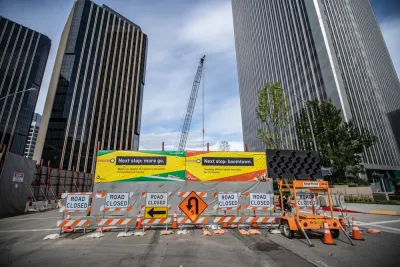Researchers are cataloging the costs of transit projects around the world in an attempt to identify ways to bring costs down and spend transit funding more efficiently.

In an article for Governing, Jared Brey describes the Transit Costs Project, which compares the costs of transit projects around the world to help identify and understand cost variations and how projects can become more cost-effective.
According to the project’s early findings, “The United States is the sixth most expensive country in the world when it comes to building rapid rail projects,” with reasons ranging “from the politicization of project management to the expanding role of consultants, the costs of labor, and efforts to limit disruption to normal traffic flow during construction.”
Governing spoke with project leader Eric Goldwyn, who said, “In the countries that are more expensive than the U.S., they’re building 65 percent or more of their projects underground, and in the U.S., we’re only building like 37 percent of our projects underground. So we’re choosing a less expensive method and we’re still very close to being the most expensive in the world.”
Goldwyn explains that long public review processes drive up costs simply due to inflation, while elaborate station plans also add to costs and reduce the number of stations that can be built under budget. High construction costs matter because they lead to drastically diminished transportation systems and fuel opposition to transit projects.
On what cities are doing right, Goldwyn says “The one thing we see is a heavy emphasis on standardization of design and really trying to economize as much as possible.” When it comes to labor costs, even cities with high worker pay rates can achieve low project costs through labor-saving technologies and other innovations. “It’s not about paying people less. It’s about, don’t spend as many hours doing something, and don’t use as many people to do that thing.”
FULL STORY: Why Are U.S. Transit Projects So Costly? This Group Is on the Case.

National Parks Layoffs Will Cause Communities to Lose Billions
Thousands of essential park workers were laid off this week, just before the busy spring break season.

Retro-silient?: America’s First “Eco-burb,” The Woodlands Turns 50
A master-planned community north of Houston offers lessons on green infrastructure and resilient design, but falls short of its founder’s lofty affordability and walkability goals.

Delivering for America Plan Will Downgrade Mail Service in at Least 49.5 Percent of Zip Codes
Republican and Democrat lawmakers criticize the plan for its disproportionate negative impact on rural communities.

Test News Post 1
This is a summary

Test News Headline 46
Test for the image on the front page.

Balancing Bombs and Butterflies: How the National Guard Protects a Rare Species
The National Guard at Fort Indiantown Gap uses GIS technology and land management strategies to balance military training with conservation efforts, ensuring the survival of the rare eastern regal fritillary butterfly.
Urban Design for Planners 1: Software Tools
This six-course series explores essential urban design concepts using open source software and equips planners with the tools they need to participate fully in the urban design process.
Planning for Universal Design
Learn the tools for implementing Universal Design in planning regulations.
EMC Planning Group, Inc.
Planetizen
Planetizen
Mpact (formerly Rail~Volution)
Great Falls Development Authority, Inc.
HUDs Office of Policy Development and Research
NYU Wagner Graduate School of Public Service





























